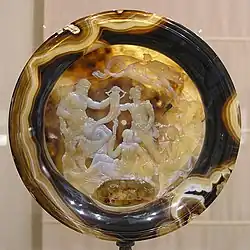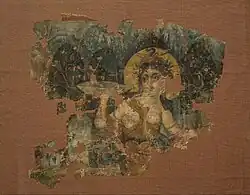Euthenia

Euthenia (Ancient Greek: Eὐθηνια) was, from the reign of Augustus through Commodus, the Greek name for a goddess and personification of abundance, particularly the abundance of wheat associated with the flooding of the Nile.[2] The Ancient Greek common noun euthenia ("prosperity, plenty, abundance")[3] like the Latin annona,[4] was used to refer to the grain-supply, and the divine personification Euthenia, was used on Roman coins in the Greek East as the Greek equivalent of either of the Roman divine personifications Annona or Abundantia.[5] She was considered to be a consort of Nilus, the Greek river god associated with the Nile.[6]
Sources

Perhaps the oldest source for the goddess is found on the Tazza Farnese (mid-second century to first century BC?), where she is depicted reclining on a Sphinx holding up two ears of wheat in her right hand.[7] Other early sources for Euthenia are found on Roman Imperial coinage of Alexandria Egypt, from the last decade of the first century BC.[8] Euthenia is also named in a votive dedicatory inscription from Anazarbus in Cilicia dated to the first or second century AD.[9] In addition to such coins, other principle sources for Euthenia are all iconographic, where she is found depicted on a variety of objects.[10]
The only literary source which mentions Euthenia as a personification dates from the fifteenth century AD. A source from the end of the sixth century AD describes the sighting of two gigantic apparitions rising up out of the Nile river, the Nile god itself, and an accompanying unnamed female (Euthenia?).[11]
Egypt
She is also a part of the Egyptian pantheon, though was later assimilated to tales related to Goddess Isis. During Ptolemaic times, she became the consort of Nilus.[12]
Notes
- ^ Jentel, p. 121 (Euthenia 1); LIMC IV.2, p. 63 (Euthenia 1).
- ^ Jentel, pp. 120–121; LSJ, s.v. εὐθηνία; RE, s.v. Euthenia.
- ^ The Cambridge Greek Lexicon, s.v. εὐθενία (variant reading εὐθενεια); LSJ, s.v. εὐθηνία.
- ^ The Pocket Oxford Latin Dictionary, s.v. annona.
- ^ Erdkamp, s.v. Annona (grain); Jentel, p. 120; LSJ, s.v. εὐθηνία.
- ^ Jentel, p. 120
- ^ Jentel, p. 121 (Euthenia 1); LIMC IV.2, p. 63 (Euthenia 1).
- ^ Kákosy, p 291.
- ^ Jentel, p. 120; RE, s.v. Eustheneia; IK Anazarbos 265.
- ^ Jentel, pp. 120–124.
- ^ Jentel, p. 120. For the divine apparitions see Theophylact Simocatta, 7.16 (pp. 201–202).
- ^ "Curtis Chapter I". www.coinsofromanegypt.org. Archived from the original on 2023-10-20. Retrieved 2020-04-07.
References
- The Cambridge Greek Lexicon, edited by J. Diggle et al, Cambridge University Press, 2021 ISBN 978-0-521-82680-8.
- Erdkamp, s.v. Annona (grain), published online 07 March 2016, in the Oxford Classical Dictionary, edited by Tim Whitmarsh, digital ed, New York, Oxford University Press. ISBN 978-0-19-938113-5.
- Jentel, s.v. Euthenia, in Lexicon Iconographicum Mythologiae Classicae (LIMC) IV.1 EROS-HERAKLES, Artemis Verlag, Zürich and Munich. 1988. ISBN 3-7608-8751-1. Internet Archive.
- Kákosy, László, "The Nile, Euthenia, and the Nymphs", in The Journal of Egyptian Archaeology, 68: 290–298. doi:10.2307/3821647. ISSN 0307-5133. JSTOR 3821647.
- Liddell, Henry George, Robert Scott, A Greek-English Lexicon, revised and augmented throughout by Sir Henry Stuart Jones with the assistance of Roderick McKenzie, Clarendon Press Oxford, 1940. Online version at the Perseus Digital Library.
- Lexicon Iconographicum Mythologiae Classicae (LIMC) IV.2 EROS-HERAKLES, Artemis Verlag, Zürich and Munich. 1988. ISBN 3-7608-8751-1. Internet Archive.
- Pauly, August, Georg Wissowa, Wilhelm Kroll, Kurt Witte, Karl Mittelhaus, Konrat Ziegler, Hans Gärtner (eds), Paulys Real-Encyclopaedie der classischen Altertumswissenschaft. Stuttgart: J. B. Metzler, 1893-1980.
- The Pocket Oxford Latin Dictionary, edited by James Morwood, Oxford University Press, 1994. ISBN 0-19-864227-X.
- Theophylact Simocatta, The History of Theophylact Simocatta, translation and "Introduction" by Michael Whitby and Mary Whitby, Oxford, 1986. Internet Archive.